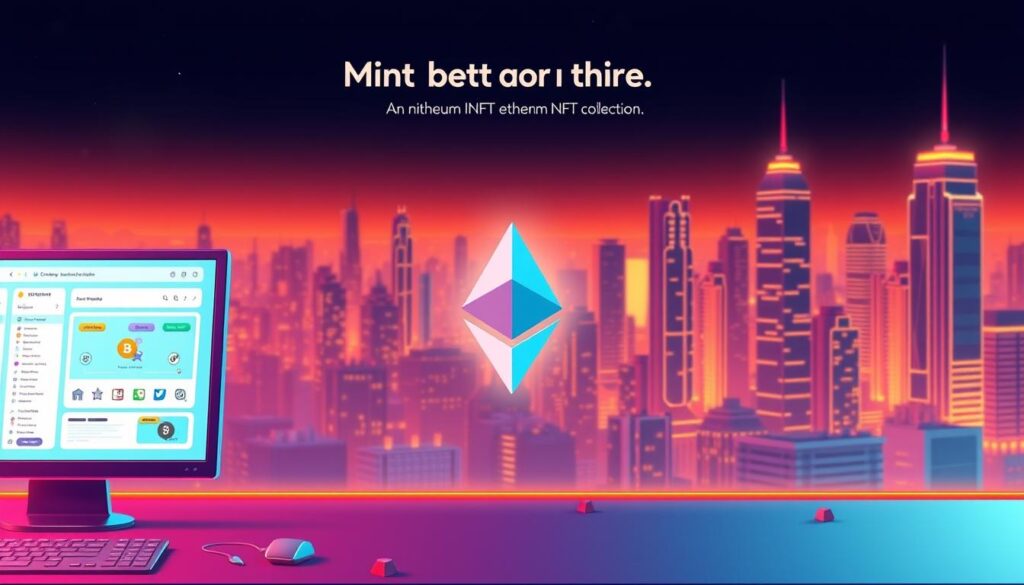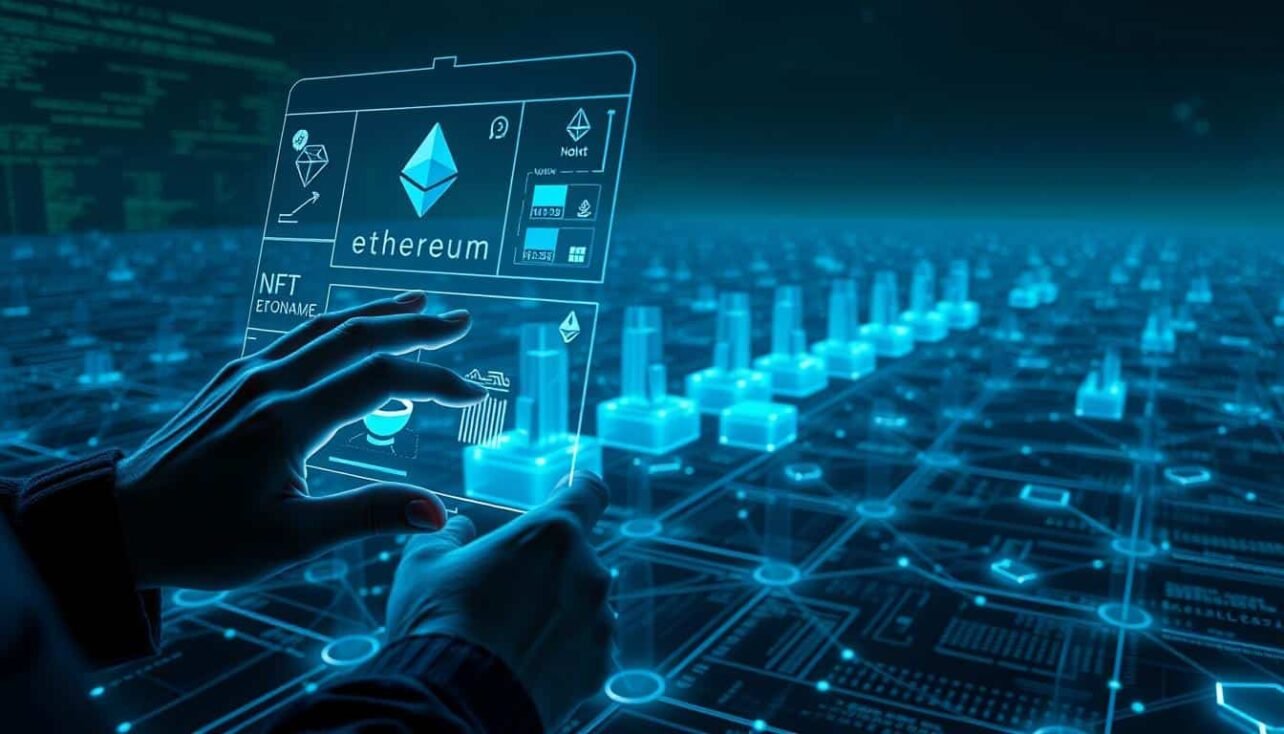Digital ownership has evolved dramatically with the rise of unique tokens that verify authenticity. These tokens, often tied to art, music, or virtual items, use blockchain technology to prove scarcity and ownership. For creators, this shift unlocks new ways to monetize work while building direct connections with audiences.
Storing digital files permanently on a decentralized ledger transforms them into tradable assets. This process, known as “minting,” ensures each item remains distinct through cryptographic identifiers. While alternatives exist, Ethereum’s robust ecosystem dominates due to its secure infrastructure and widespread adoption by major marketplaces.
The cultural impact of these tokens spans industries. Musicians release exclusive albums, athletes tokenize memorabilia, and brands create limited-edition virtual goods. This trend highlights how technology reshapes value exchange beyond traditional currencies.
Key Takeaways
- Unique tokens provide verifiable ownership of digital assets through blockchain.
- Minting permanently stores files on decentralized networks like Ethereum.
- Ethereum’s established tools make it the top choice despite newer platforms.
- Creators gain control over distribution and royalties with this technology.
- Cultural adoption spans art, sports, and entertainment industries globally.
Understanding NFTs and the Blockchain Landscape
The advent of blockchain has introduced a new paradigm for verifying digital uniqueness. Non-fungible tokens (NFTs) act as cryptographic certificates, embedding distinct identifiers into each digital asset. Unlike interchangeable cryptocurrencies, these tokens carry irreplaceable data – similar to a fingerprint on a barcode.

This non-fungibility solves a critical problem in creative industries. Before NFTs, digital art or music files could be duplicated infinitely with no method to trace original works. Now, creators attach permanent ownership records through decentralized ledgers. Blockchain technology ensures these records remain tamper-proof and publicly accessible.
Ownership of an NFT doesn’t mean controlling the underlying file. Instead, it represents verified rights to a specific version of that asset. This distinction often causes confusion but highlights the technology’s precision in tracking provenance.
Beyond visual art, applications range from concert tickets to virtual real estate deeds. Musicians release limited-edition albums as tokens, while athletes tokenize highlight reels. Each use case relies on blockchain’s ability to authenticate scarcity in a trustless environment.
Benefits of Minting NFTs for Creators
Digital innovators now unlock transformative opportunities through tokenization. By converting work into blockchain-certified assets, creators establish irrefutable proof of ownership. This process combats piracy while enabling new revenue streams previously unavailable in traditional digital markets.

Programmable royalties redefine financial sustainability. When a piece sells in secondary markets, smart contracts automatically send 5-10% of proceeds back to the original creator. This method ensures ongoing compensation without relying on third-party intermediaries.
Direct engagement with collectors reshapes creative careers. Platforms eliminate gatekeepers, letting artists set prices and terms independently. A digital creation guide shows how this autonomy fosters stronger community connections.
Scarcity mechanics elevate digital work’s perceived value. Limited editions or unique variants create exclusivity, mirroring physical art markets. Simultaneously, blockchain’s borderless nature lets creators reach global audiences instantly – no gallery shows or distribution deals required.
These advancements position tokenization as more than a trend. They represent a fundamental shift in how society values digital craftsmanship. Early adopters gain competitive advantages in this rapidly evolving space.
Getting Started with Your NFT Wallet and Marketplace
Establishing your presence in the digital collectibles space begins with two critical tools: a secure wallet and a compatible platform. These components work together to store assets and connect you with global audiences.

Setting Up Your Crypto Wallet
MetaMask remains the most widely used wallet for interacting with platforms like OpenSea. After installing the browser extension or mobile app, create a new account and store your recovery phrase offline. Never share these 12-24 words – they’re the master key to your digital assets.
Fund your wallet using cryptocurrency purchased through exchanges. Transfer ETH from platforms like Coinbase to your wallet address, ensuring you have enough for transaction fees. Enable two-factor authentication for added security.
Selecting the Right NFT Marketplace
Platforms vary in focus and fees. OpenSea charges 2.5% per sale plus gas fees, ideal for beginners exploring multiple formats. SuperRare caters to high-end art with strict curation, while Rarible offers more flexibility for emerging creators.
Consider these factors when choosing:
- Fee structures (listing costs vs. percentage cuts)
- Community engagement levels
- Supported file types and blockchain networks
Most marketplaces require connecting your wallet before uploading files. Review each platform’s verification process – some demand identity checks for premium features.
Step-by-Step Guide: how to mint NFT collection on Ethereum blockchain
Crafting a tokenized collection begins with strategic organization and platform navigation. Start by preparing digital assets in compatible formats like PNG or MP4, ensuring files stay under 100MB. Create metadata templates detailing traits, descriptions, and rarity tiers to streamline the minting process.

Connect your crypto wallet to platforms like OpenSea using the “Wallet Connect” feature. Navigate to the creation dashboard and select “New Collection” if launching multiple pieces. This step establishes branding elements such as logos and banner images for your series.
- Upload your primary file and add a distinctive title
- Include descriptive text highlighting unique attributes
- Set royalty percentages between 5-10% for secondary sales
- Choose Ethereum from blockchain options
- Review gas fees before confirming
Marketplaces often provide preview modes to check asset display quality. Optimize metadata tags with relevant keywords to improve discoverability. For example, artists might include “generative art” or “1/1 edition” in descriptions.
Address common errors by ensuring wallet balances cover gas fees. If transactions stall, adjust fee priorities or retry during low-network congestion. Most platforms offer transaction history tabs to monitor minting status in real time.
Using Smart Contracts to Mint NFTs
Smart contracts unlock advanced customization for digital creators seeking full control over their work. These self-executing agreements automate processes like ownership transfers and royalty payments while enforcing predefined rules. Unlike standard marketplace tools, they enable unique features such as dynamic pricing or multi-stage reveals.
Understanding Contract Verification
Always confirm a smart contract’s legitimacy before interaction. Verified contracts display a blue checkmark next to their address on Etherscan. This confirmation means developers publicly shared the code, allowing anyone to review its functions and security measures.
Unverified contracts pose significant risks. Their hidden code could contain malicious functions draining wallets or locking assets. Stick to audited agreements from reputable sources to protect your investments.
Interacting with Smart Contracts via Etherscan
Etherscan’s interface simplifies direct contract interactions for experienced users. Navigate to the “Write Contract” section after locating the verified agreement. Look for functions like safeMint or batchMint – these initiate the creation process when properly configured.
Essential steps include:
- Connecting your wallet through Web3 providers
- Entering recipient wallet addresses
- Approving gas fees for network processing
Complex contracts often require higher transaction costs due to increased computational demands. Monitor real-time gas trackers to optimize timing and reduce expenses.
Navigating Costs and Gas Fees for NFT Minting
Managing expenses requires strategic planning and timing in blockchain transactions. Gas fees – the fuel powering network operations – fluctuate based on demand. These costs can swing from single digits to hundreds of dollars within hours.
Tracking Network Activity
Real-time monitoring tools like Etherscan reveal current gas prices. The network typically sees lower activity during weekends and late-night UTC hours. Savvy creators schedule bulk operations during these windows to maximize savings.
| Time Period | Average Gas Fee | Cost Savings |
|---|---|---|
| Weekday Peak | $45-$180 | 0% |
| Weekend Off-Peak | $8-$25 | 70-85% |
| Late Night (UTC) | $5-$15 | 90-95% |
Optimizing Transaction Batches
Combining multiple actions into single transactions reduces total fees. This method works particularly well for series releases or metadata updates. Some platforms allow 10-50 items per batch, dramatically lowering per-unit costs.
Emergency scenarios demand quick decisions. If fees spike mid-process, cancel pending transactions through wallet interfaces. Adjust gas priority settings to either speed up or abort stalled operations.
Budget-conscious creators use fee calculators to predict expenses. Set maximum price limits before confirming transactions. These precautions prevent unexpected drains on crypto reserves during volatile periods.
Tips for Batch Minting and Metadata Optimization
Efficient production methods separate successful digital projects from costly experiments. Strategic grouping of assets cuts transaction fees while maintaining quality. This approach proves essential when launching series with hundreds of pieces.
Optimizing NFT Metadata and File Size
Standardized templates streamline metadata creation. Store essential details like traits and descriptions off-chain using JSON files. Keep on-chain data minimal – reference external storage links instead of embedding full content.
File compression balances quality with cost efficiency. Consider these format comparisons:
| File Type | Max Size | Cost Impact | Platforms Supported |
|---|---|---|---|
| PNG (Lossless) | 50MB | High | 98% |
| MP4 (720p) | 100MB | Medium | 89% |
| WAV (Audio) | 30MB | High | 76% |
| GLB (3D) | 150MB | Critical | 64% |
IPFS integration preserves decentralization for large files. Use pinning services to prevent data loss. Pair this with automated scripts that rename and organize art assets programmatically.
Three rules for cost-effective batches:
- Process 20-50 tokens per transaction
- Set fixed gas limits to avoid spikes
- Test metadata visibility across devices
Tools like HashLips simplify bulk operations. These generators handle everything from rarity calculations to layered asset combinations. Creators maintain artistic control while eliminating manual repetition.
Remember: Over-engineering smart contracts inflates fees. Stick to basic verification functions unless your collection requires dynamic features. Audit contracts through third-party services before deployment.
Exploring Alternative Blockchains for Cost Efficiency
Expanding beyond established networks unlocks new possibilities for digital asset creators. Emerging platforms provide lower fees, faster transactions, and environmental benefits compared to traditional systems.
High-Speed Low-Cost Networks
Solana’s network processes transactions at $0.015 each – ideal for large series. Polygon slashes costs below $0.01 while supporting Ethereum-compatible wallets. Tezos balances affordability ($0.50 per token) with energy-efficient validation methods.
Eco-Conscious Platforms Gain Traction
Flow blockchain, built for digital collectibles, charges under $0.10 per mint. Its proof-of-stake model appeals to environmentally aware creators. Binance Smart Chain offers mid-range fees ($0.15-$1) with multi-chain flexibility.
Choosing the right platform depends on collection size and values. Budget-focused projects thrive on Solana, while eco-friendly marketplaces favor Tezos. Always test small batches before full launches.
These alternatives demonstrate how blockchain diversity empowers creators to optimize costs without sacrificing quality. As the space evolves, new networks will continue reshaping digital ownership economics.


No comments yet